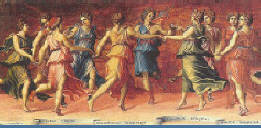Clouds
Clouds is a fanciful depiction of clouds racing over the sky written in eleven stanzas and
irregularly rhymed.
Warships rush into battle but the approach of calmer skies brings peace talks followed by the
resumption of commerce and the cessation of hostilities.
The poem concludes with the admission that clouds are merely the embodiment of imaginaton
and a stimulus to thought.
Enid
Any poem entitled Enid must immediately be recognizable as a tribute to one of our most
prolific children's authors. This one was conceived after visiting the house where she lived
in the 1930s and 1940s and where she created numerous works for children.
The poem consists of five stanzas each of eight lines rhymed FH.
I have adopted the spirit of her writing by incorporating the names of two of her houses and
her then location in addition to several references to her works; but I leave the reader to
discover them as well as, in the tradition of her stories, the hidden mystery.
Evening
An evocation of the peace of evening descending on a pastoral scene. Bells chime from a
distant tower, air breathes softly over fields; and waters flow silently as twilight gathers
to foretell contentment until the morning.
Format: Seven stanzas of eight lines rhymed BH or FH; or nine lines rhymed GI or EI
Gold
A tale of the love of gold by a man living alone whose only delight is to count his coins in
the belief that they are his greatest joy and security. He is mistakenly unaware that his
wealth is known to his neighbour whom he despises for his poverty. The neighbour, however,
harbours another kind of wealth within the bosom of his family and in the countryside
around. The poem ends with a morality tale of the pursuit of gold.
Format is nine heavily rhymed stanzas the last of which is the morality tale in rhymed couplets.
Moon
Moon is the poet's obligatory address to the royalty of night where I address the moon as a
king rather than as a queen as it is normally considered probably having been aided by its
gender in the French language (but the gender is masculine in the German language). It
consists of seven stanzas each of eight lines of two quatrains rhymed AD (mostly) and EH.
It describes the passage of the moon across the heavens and the benevolence of its beams upon
the earth beneath. The moon is represented as a former king who has lost his might but
nonetheless retains his train as represented by the tide and leaves the darkness in order
to consult even less fortunate companions during the day and to gain new strength for the
following night.
Revolution Dawn
Revolution Dawn consists of five stanzas, the first two being of ten lines, rhymed EJ, followed
by three stanzas each of nine lines, rhymed EI.
The poem recounts the dawn as a revolution overturning the existing regime. The town is
safely sleeping whilst revolutionaries gather in the eastern mountains where their
flickering torches gradually overcome the blackness of the past. As the darkness fades,
sympathisers reach the town causing the old regime to flee headlong. Unstoppable riot
bursts with ease over the horizon and stands proudly forth to announce the bright new day.
Roundabouts
A comment on the righteous indignation of a victor who adopts the hostile attitudes of the
vanquished in his subsequent conduct with which the former oppressed subjects now readily
comply. Questioning of the new politics is deprecated, however slight it may be.
Format is three stanzas of fourteen lines and is only sparsely rhymed.
The Artiste
The Artiste consists of four 'Petrarchan' sonnets each rhymed MN followed by two concluding
postludes each of six lines irregularly rhymed.
It is a homage to the creator of words and the wonderment of the protagonist at their source.
Because one is conjuring words from nowhere or from some inchoate source, the task is
seemingly impossible. Where do they come from; are they derived through nurture or from
searching; and how is the presence of a source divined?
The answer is in the postlude: simply determination to resolve the difficulty.
The Final Port of Call
By means of a sailing metaphor, The Final Port of Call displays our response to the
challenges of life. Our ambitious attempts to earn our living and a place in society which,
when attained, gives respect, prosperity and influence have, regardless of our
achievements, no guarantee of continued success when faced by the ravages of life and the
inevitability of its cessation. We finally succumb to the power of nature that proves more
powerful than any challenge faced, so far, and ends with loss of control beyond the final
port, the grave.
Format consists of seven stanzas of nine lines and a final stanza of ten lines all irregularly rhymed.
The Sinking Sun
The Sinking Sun consists of five stanzas each of nine lines rhymed EI.
The poem portrays the sun as a bombastic ruler finally defeated by the night. It descends
from dominance of the heavens to disappear forever, one knows not where. It is succeeded by
the minor figures, previously invisible within its glare, who now welcome the gentler
governance of the widowed moon. Sun has blazed too hard and, therefore, has consumed its
strength and been deposed. Day departs to be succeeded, perhaps, by a more enlightened
ruler.
To Music
A tribute to music from martial through pastoral to romantic and devotional concluding with
thanks to its composers and a plea that it should not cease.
Format is three stanzas of twelve lines rhymed JL, one of six lines rhymed DF and one of
seven lines vaguely rhymed.
|
